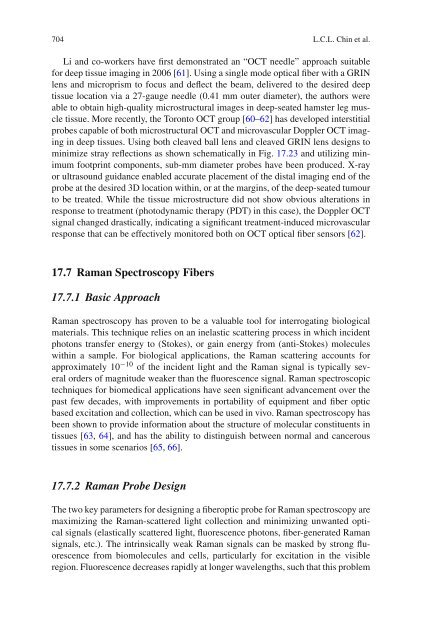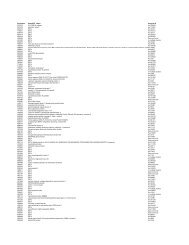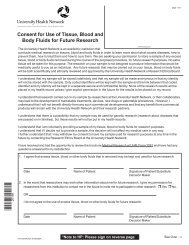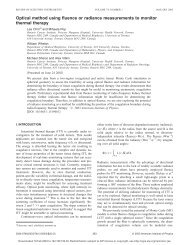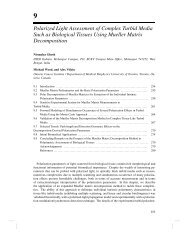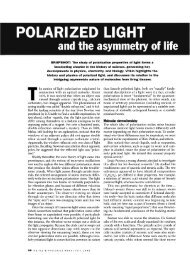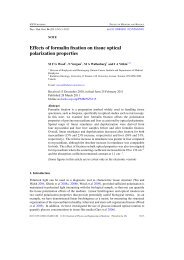Optical Fiber Sensors for Biomedical Applications
Optical Fiber Sensors for Biomedical Applications
Optical Fiber Sensors for Biomedical Applications
You also want an ePaper? Increase the reach of your titles
YUMPU automatically turns print PDFs into web optimized ePapers that Google loves.
704 L.C.L. Chin et al.Li and co-workers have first demonstrated an “OCT needle” approach suitable<strong>for</strong> deep tissue imaging in 2006 [61]. Using a single mode optical fiber with a GRINlens and microprism to focus and deflect the beam, delivered to the desired deeptissue location via a 27-gauge needle (0.41 mm outer diameter), the authors wereable to obtain high-quality microstructural images in deep-seated hamster leg muscletissue. More recently, the Toronto OCT group [60–62] has developed interstitialprobes capable of both microstructural OCT and microvascular Doppler OCT imagingin deep tissues. Using both cleaved ball lens and cleaved GRIN lens designs tominimize stray reflections as shown schematically in Fig. 17.23 and utilizing minimumfootprint components, sub-mm diameter probes have been produced. X-rayor ultrasound guidance enabled accurate placement of the distal imaging end of theprobe at the desired 3D location within, or at the margins, of the deep-seated tumourto be treated. While the tissue microstructure did not show obvious alterations inresponse to treatment (photodynamic therapy (PDT) in this case), the Doppler OCTsignal changed drastically, indicating a significant treatment-induced microvascularresponse that can be effectively monitored both on OCT optical fiber sensors [62].17.7 Raman Spectroscopy <strong>Fiber</strong>s17.7.1 Basic ApproachRaman spectroscopy has proven to be a valuable tool <strong>for</strong> interrogating biologicalmaterials. This technique relies on an inelastic scattering process in which incidentphotons transfer energy to (Stokes), or gain energy from (anti-Stokes) moleculeswithin a sample. For biological applications, the Raman scattering accounts <strong>for</strong>approximately 10 −10 of the incident light and the Raman signal is typically severalorders of magnitude weaker than the fluorescence signal. Raman spectroscopictechniques <strong>for</strong> biomedical applications have seen significant advancement over thepast few decades, with improvements in portability of equipment and fiber opticbased excitation and collection, which can be used in vivo. Raman spectroscopy hasbeen shown to provide in<strong>for</strong>mation about the structure of molecular constituents intissues [63, 64], and has the ability to distinguish between normal and canceroustissues in some scenarios [65, 66].17.7.2 Raman Probe DesignThe two key parameters <strong>for</strong> designing a fiberoptic probe <strong>for</strong> Raman spectroscopy aremaximizing the Raman-scattered light collection and minimizing unwanted opticalsignals (elastically scattered light, fluorescence photons, fiber-generated Ramansignals, etc.). The intrinsically weak Raman signals can be masked by strong fluorescencefrom biomolecules and cells, particularly <strong>for</strong> excitation in the visibleregion. Fluorescence decreases rapidly at longer wavelengths, such that this problem


